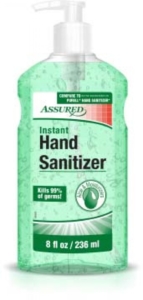Be wary of bad hand sanitizers
 By NCL Executive Assistant Adrienne Archer
By NCL Executive Assistant Adrienne Archer
Hand sanitizers help protect and prevent the spread of COVID-19 when soap and water are not readily available. When the coronavirus first emerged, demand for hand sanitizers soared. Stores were unable to maintain ample inventory, resulting in rampant hoarding and price gouging. Essential workers that desperately needed hand sanitizer couldn’t get them, prompting some companies to start making sanitizers that originally did not produce them (i.e. distilleries, cosmetic companies, etc.)
Guidelines from the Centers for Disease Control and Prevention (CDC) require hand sanitizer to have at least 60 percent ethanol (ethyl alcohol) in order for it to be effective. The CDC does not encourage members of the public to make hand sanitizer for individual use.
 The Food and Drug Administration (FDA) has observed a sharp increase in those that, in addition to ethanol, also contain methanol—an ingredient that can be toxic when absorbed through the skin and can be fatal when ingested. Children and adults ingesting certain sanitizers led to blindness, hospitalizations, and even death.
The Food and Drug Administration (FDA) has observed a sharp increase in those that, in addition to ethanol, also contain methanol—an ingredient that can be toxic when absorbed through the skin and can be fatal when ingested. Children and adults ingesting certain sanitizers led to blindness, hospitalizations, and even death.
Extended exposure to methanol can cause nausea, vomiting, seizures, permanent blindness, or death. The FDA has also found sanitizers with 1-propanol are also harmful. Accidental ingestions can cause central nervous system depression or death. Consumers that may have been exposed to hand sanitizers containing methanol or 1-propanol should seek medical attention immediately.
The FDA recently updated its *guidelines on temporary policies about testing hand sanitizers to determine methanol levels. As companies produce hand sanitizers, they should frequently test to ensure that methanol is not created as a byproduct of either ethanol or isopropyl alcohol. The testing should be performed by an FDA inspected lab to ensure that it has met current good manufacturing practice (CGMP) standards. CGMP ensures the proper design, monitoring, and control of manufacturing processes and facilities. If alcohol (ethanol) has been found to contain more than 630 parts per million of methanol, it is contaminated and should be disposed of in hazardous waste containers. This *guidance serves to help state-licensed pharmacies and outsourcing facilities report any incidents. The FDA has guidelines for an additional deterrent formula of alcohol to prevent children from ingesting them.
Consumers should also be cautious of false claims that hand sanitizers provide prolonged protection against COVID-19. Carefully inspect any purchased hand sanitizers to see if methanol or 1-propanol is listed.
FDA maintains a current list of hand sanitizers that are not recommended. As consumers review the list, they should compare the manufacturer name, product name, and National Drug Code (NDC) # on the hand sanitizer. If you find a product on the list, dispose of it immediately in a hazardous waste container and NOT down the drain.
The FDA encourages health professionals, consumers, and patients to report adverse effects and problems to the FDA’s MedWatch Adverse Event Reporting Program. Questions can be emailed to COVID-19-HandSanitizers@FHA.nns.gov. The FDA has also created a quiz to test consumer’s knowledge about hand sanitizers and a Q&A section on hand sanitizers and COVID-19 to keep consumers informed.
*Links are no longer active as the original sources have removed the content, sometimes due to federal website changes or restructurings















